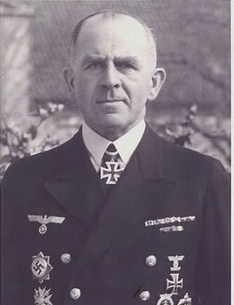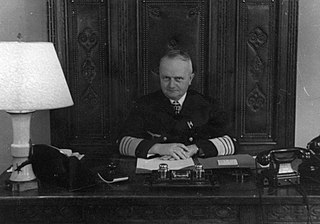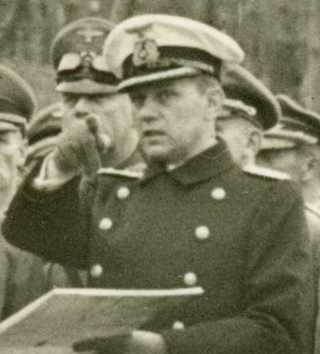
The Reichsmarine was the name of the German Navy during the Weimar Republic and first two years of Nazi Germany. It was the naval branch of the Reichswehr, existing from 1919 to 1935. In 1935, it became known as the Kriegsmarine, a branch of the Wehrmacht; a change implemented by Adolf Hitler. Many of the administrative and organizational tenets of the Reichsmarine were then carried over into the organization of the Kriegsmarine.

Erich Johann Albert Raeder was a German admiral who played a major role in the naval history of World War II and was convicted of war crimes after the war. He attained the highest possible naval rank, that of grand admiral, in 1939. Raeder led the Kriegsmarine for the first half of the war; he resigned in January 1943 and was replaced by Karl Dönitz. At the Nuremberg trials he was sentenced to life imprisonment but was released early owing to failing health in 1955.

Bernhard Rogge was a German naval officer who, during World War II, commanded a merchant raider. Later, he became a Konteradmiral in West Germany's navy.

Otto Ernst Lindemann was a German Kapitän zur See. He was the only commander of the battleship Bismarck during its eight months of service in World War II.

Kommodore was the highest senior officer rank in the German Kriegsmarine, comparable to commodore in anglophone naval forces. There was no counterpart in the German Heer and Luftwaffe, but Kommodore would have been comparable to Oberführer in the Waffen-SS.

Otto Ciliax was a German naval officer who served in the navies of the German Empire, the Weimar Republic and Nazi Germany. As an admiral during World War II, he commanded the German battleships. He was a recipient of the Knight's Cross of the Iron Cross.

Helmuth Brinkmann was a Vizeadmiral in the Kriegsmarine during World War II who captained the heavy cruiser Prinz Eugen. Prior to World War II he commanded the aviso Grille, Adolf Hitler's state yacht. He was also a recipient of the Knight's Cross of the Iron Cross of Nazi Germany. Brinkmann surrendered to British troops in 1945 and was held until 1947.

Alfred Saalwächter was a high-ranking German U-boat commander during World War I and General Admiral during World War II.

Theodor Burchardi was an Admiral with the Kriegsmarine during World War II and recipient of the Knight's Cross of the Iron Cross with Oak Leaves of Nazi Germany. He was responsible for organising the evacuation of 2 million people from Courland and Eastern Prussia at the end of World War II in Operation Hannibal and the Evacuation of East Prussia.

Otto Schniewind was a German General Admiral during World War II. He was a recipient of the Knight's Cross of the Iron Cross of Nazi Germany.

Rolf Hans Wilhelm Karl Carls was a high-ranking German admiral during World War II. He was a recipient of the Knight's Cross of the Iron Cross of Nazi Germany.

Kurt Fricke was an Admiral with the Kriegsmarine (navy) of Nazi Germany during World War II and a recipient of the Knight's Cross of the Iron Cross.

Hans-Jürgen "Hansjürgen" Rudolf Reinicke was a Kapitän zur See, commander of heavy cruiser Prinz Eugen, in Nazi Germany's Kriegsmarine during the Second World War and recipient of the Knight's Cross of the Iron Cross.

Kurt-Caesar Hoffmann was a senior naval commander in the German Navy (Kriegsmarine) during World War II, who commanded the battleship Scharnhorst. He was a recipient of the Knight's Cross of the Iron Cross.

Johann Günther Lütjens was a German admiral whose military service spanned more than 30 years and two world wars. Lütjens is best known for his actions during World War II and his command of the battleship Bismarck during her foray into the Atlantic Ocean in 1941. He was killed in action during the last battle of the battleship Bismarck.

Gustav Kleikamp was a German naval officer, and a Vizeadmiral in Nazi Germany's Kriegsmarine.
The Fleet commander of the Kriegsmarine (Flottenchef) was the highest ranked administrative officer in the organization of the Kriegsmarine, and served as a member of the Oberkommando der Marine. The fleet commander did not actually serve as commander of an at-sea fleet, but instead was the senior officer to which the vessel type commanders reported. The position of fleet commander was created from an older position of the Reichsmarine known as Der Oberbefehlshaber der Seestreitkräfte.
A type commander in the Kriegsmarine was a permanently assigned administrative officer in the organization of the Kriegsmarine which oversaw the development, deployment, and in some cases operational activities of the various classes of German naval vessels. Due to cross jurisdiction with the Navy group commanders, who tactically commanded all vessels at sea, some type commanders were little more than ceremonial officers who held a title with little authority. Others, such as Karl Dönitz who commanded the German U-boat force, exercised near total independence and held enormous authority, both operationally and administrative.
Fritz Krauss was a German naval officer, most recently a Konteradmiral in the World War II. Between 16 August 1944 – 22 July 1945, Fritz Krauss was Director of Department of Naval Intelligence, specifically 3 SKL/MND IV of the German Navy.
Paul Wever was a German naval officer, Vizeadmiral of the Kriegsmarine during World War II. Paul Wever belonged to the generation of men who were sent to war, twice. Between 1 January 1940 to 21 June 1940 was director of the Department of Navy Message Evaluation, later called (3/SKL) Naval Operations of the Naval War Command. The unit was specifically concerned with Naval Intelligence.
















